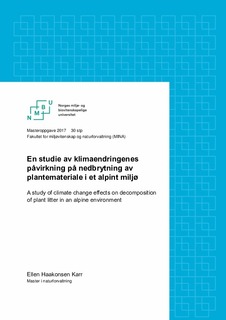| dc.contributor.author | Haakonsen Karr, Ellen | |
| dc.coverage.spatial | FInse, Norge | nb_NO |
| dc.date.accessioned | 2017-11-27T15:20:23Z | |
| dc.date.available | 2017-11-27T15:20:23Z | |
| dc.date.issued | 2017-05-15 | |
| dc.identifier.uri | http://hdl.handle.net/11250/2468169 | |
| dc.description.abstract | Sammendrag De pågående klimaendringene påvirker mange naturtyper og økosystemer over hele verden. Arktiske og alpine miljøer er regnet som særlig utsatt, og det er store mengder karbon lagret i disse områdene. Nedbrytningsprosesser er viktige faktorer i global oppvarming, da nedbrytning av organisk materiale fører til utslipp av klimagasser. Global oppvarming ventes å føre til en høyere aktivitet i nedbryterorganismer, noe som igjen vil kunne føre til et høyere utslipp av CO2. Derfor er fokus på disse områdene viktig.
I denne studien har jeg undersøkt hvordan oppvarming kan påvirke nedbrytningsprosessene i fjellet, ved bruk av en forenklet «litter-bag» metode. Mine litter-bags var i form av grønn te og Rooibos-te. Denne metoden heter Tea Bag Index, og måler nedbrytningshastighet (k) og andel stabilisert materiale (S). Teposene ble gravd ned på fjellet Sanddalsnuten i Finse, og lå der i 3 måneder før de ble gravd opp igjen. Det ble brukt to forsøksfelt, hvorav det ene Oppvarmingsfeltet, hadde kunstig oppvarmete flater (OTC) og kontroll, og det andre, Rehabiliteringsfeltet, hadde tidligere gjødslede flater, tidligere oppvarmede flater, en kombinasjon av disse, og kontroll.
ANOVA ble brukt for å undersøke signifikans, både i Oppvarmingsfeltet og Rehabiliteringsfeltet. Det ble brukt Tukey-test i Rehabiliteringsfeltet for å undersøke hvilke av behandlingene som var mest forskjellige fra hverandre.
Jeg fant at nedbrytningshastighet (k) var signifikant høyere i kontrollflater sammenlignet med OTC i Oppvarmingsfeltet. I Rehabiliteringsfeltet var nedbrytningshastighet (k) signifikant høyere i tidligere gjødslete og oppvarmede flater i forhold til de andre.
Den mest sannsynlige årsaken til at nedbrytningshastigheten var høyere i kontroll-flater i Oppvarmingsfeltet var tørke grunnet bruk av OTC. Nedbrytningshastigheten økte sannsynligvis i gjødslete og oppvarmede flater grunnet påvirkning på jordorganismer, men dette kunne ikke bekreftes.
Studien viste at fuktighet er svært vesentlig i nedbrytningsprosesser, også i kaldt klima. I tillegg var det tydelig i Rehabiliteringsfeltet at menneskelige endringer i naturmiljøet kan ha langvarige konsekvenser. Det anbefales i fremtidige studier å foreta målinger av jordfuktighet. | nb_NO |
| dc.description.abstract | The ongoing climate change affects many ecosystems and natural environments all over the world. Arctic and alpine environments are especially susceptible to climate change, and there are large amounts of carbon stored in the ground in these areas. Decomposition processes are important factors in global warming, as the decomposition of organic material causes CO2 emissions. Global warming is expected to increase this activity, which again can increase CO2 emissions. That is why it is important to focus on these areas.
In this study I have investigated how warming might affect decomposition processes in a mountain site, by the use of a simplified litter-bag method. The litter-bags used in my study were tea bags, green and Rooibos. This method is called the Tea Bag Index, and consists of the two parameters decomposition rate (k) and litter stabilisation factor (S). The tea bags were buried at a mountain site in Finse in the beginning of June, and were left there to decompose for three months before retrieval. I used two study sites, one which had artificial warming plots and control plots (called the Warmed field), and one that had warmed plots, fertilized plots, a combination and control (called the Recovery field).
ANOVA was used to examine if there was a significant difference between treatments in both fields. Tukey-test was used the Recovery field to check if any of the treatments differed from one another.
I found that decomposition speed (k) was significantly higher in the control-plots compared with the warmed plots in the Warmed field. In the Recovery field decomposition speed (k) was significantly higher in the plots that were both warmed and fertilized, compared to the others.
The most likely cause that decomposition speed was higher in control-plots was draught caused by OTC. The decomposition speed was most likely higher in the warmed and fertilized plots because they were affected by decomposition organisms, although this could not be confirmed.
The study showed that moisture is highly important in decomposition processes, even in a cold climate. In the Recovery field it was apparent that human induced changes in the environment can have long lasting effects. It is recommended to measure soil moisture in future studies. | nb_NO |
| dc.language.iso | nob | nb_NO |
| dc.publisher | Norwegian University of Life Sciences, Ås | nb_NO |
| dc.rights | Attribution-NonCommercial-NoDerivatives 4.0 Internasjonal | * |
| dc.rights.uri | http://creativecommons.org/licenses/by-nc-nd/4.0/deed.no | * |
| dc.subject | Nedbrytning | nb_NO |
| dc.subject | Klimaendringer | nb_NO |
| dc.subject | Alpint mijø | nb_NO |
| dc.title | En studie av klimaendringenes påvirkning på nedbrytning av plantemateriale i et alpint miljø | nb_NO |
| dc.title.alternative | A study of climate change effects on decomposition of plant litter in an alpine environment | nb_NO |
| dc.type | Master thesis | nb_NO |
| dc.description.version | submittedVersion | nb_NO |
| dc.subject.nsi | VDP::Matematikk og Naturvitenskap: 400 | nb_NO |
| dc.source.pagenumber | 33 | nb_NO |
| dc.description.localcode | M-NF | nb_NO |

